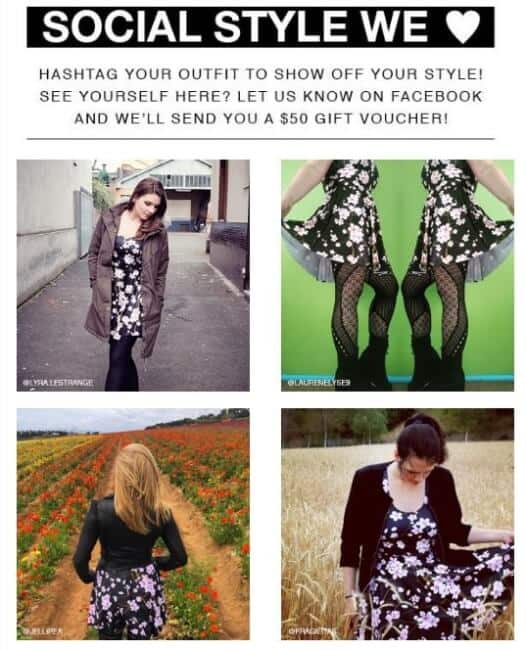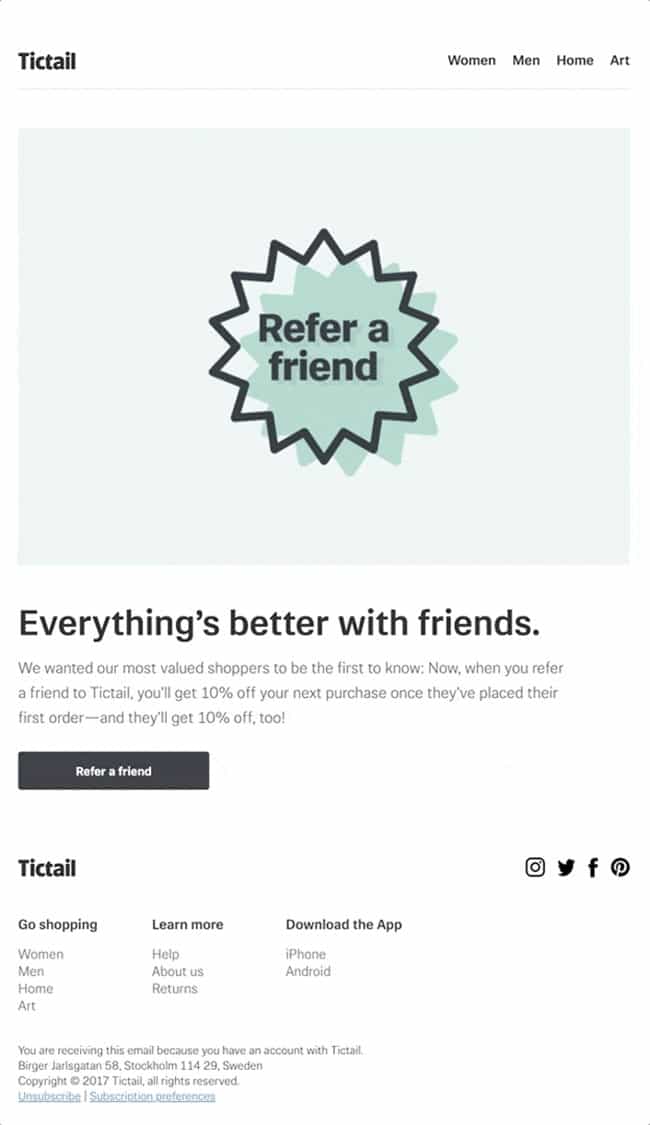Updated July 2019
Email is a revenue-driving machine. It reigns supreme as the most powerful marketing channel in terms of ROI, returning $38 for every $1 you spend. What’s more: It converts 40 times as many customers as social media.
But just because you have some email content and a list of subscribers doesn’t mean you’re getting the maximum benefit out of your email marketing campaigns.
In this post, we’ll take a look at 12 things you can do to improve your email marketing by driving subscriber engagement, improving CTR, and curating more compelling content.
How do you develop an email marketing strategy?
First things first, you need to make a plan based on what you hope to accomplish. Emails aimed at lead nurturing need to be handled differently than emails used to increase engagement and conversions.
When planning your email strategy, you should ask yourself these questions:
- Who are you sending your emails to?
- What is the reason for sending your emails?
- What types of emails will you send?
- What do you want the emails to look like?
- How often will you send the emails?
After deciding how you want to build your email strategy, follow these email marketing tactics to make your campaign a success.
1. Use personalization for customer retention
Over 75% of email revenue is generated by triggered, personalized campaigns rather than one-size-fits-all campaigns according to DMA.
That said, personalization is a must for customer retention. We all know it’s cheaper to keep an existing customer than to acquire a new one. Personalization nurtures your customers, keeping them engaged and interested by staying relevant and specific to their needs.
So how do you nail personalization? You can deploy:
- Cart abandonment reminders featuring subscriber-relevant products
- Personalized copy that leverages customer data you’ve collected
- Location-specific images/offers that make emails feel hyper-relevant
Just remember: Personalization should be personal. Make sure your copy reads like it was written for a human, not just an inbox.
2. Create subject lines that improve conversions
Just like the headline in traditional copywriting, your subject line is the only part most people read. In the case of email, it’s what determines whether or not they open it.
Of all the personal data you can collect for targeted emails, one of the most important pieces is your subscriber’s first name. Subject lines featuring a first name have a 26% higher open rate.
Be aware of length when writing a subject line. 50% of emails are opened on a mobile device, and iPhones can only show between 35–38 characters in portrait mode—so aim for subject lines in the 17–24 character range. And try to keep it to 3–5 words.
If you need suggestions for a killer subject line, here are twenty to get you started along with subject line best practices backed by hard data.
3. Try segmentation-triggered automation
Once you know a thing or two about your customers, it’s time to segment them into categories based on their behavior, interests, and where they are in the buyer’s journey. Use behavioral segments to segment users based on how they’ve interacted with your website in the past.
Segments and behavior data can then be used to trigger automated emails that deliver your most relevant content exactly when it’s most needed (like on a subscriber’s birthday, post-purchase, etc.).
4. Personalize with dynamic content
Campaign Monitor’s tools make it easy to customize your content to fit different customer segments using simple drag-and-drop tools.
So how do you do that? Dynamic content allows you to customize pretty much everything about an email to suit the recipient.
With this type of personalized email content, you can boost the relevancy of your messages so your email marketing drives clicks (and sales) without forcing you to invest hours of time in creating several different individual campaigns.
5. Take advantage of user-generated content
A great way to encourage engagement in your email campaigns is to ask your customers to submit user-generated content (UGC). Not only does this give your customers a chance to interact directly with your brand, but it also influences other people to make purchases themselves. Adweek reports that 85% of people say UGC is more likely to convince them to buy than photos from a brand or company.
The best way to run a successful UGC email strategy is by using a hashtag. You’ll promote the hashtag in your emails and ask your customers to post hashtagged photos of themselves on social media using your products.
Source: Top Dog Social Media
Black Milk Clothing utilized this email tactic and even included the best photos in their future emails. Users eagerly opened the brand’s emails hoping to see their photos to receive a discount.
6. Promote social sharing
There are other ways to integrate your social media and email marketing strategy to improve your overall campaigns. You can utilize social media to grow your email list. You’ll do this by either posting something to your followers or running an ad with a signup form.
On the flip side, you can also use emails to encourage your contacts to follow you on social media. Many emails include social icons in the footer that will allow customers to see your social channels. However, you should also design your emails so your customers can share a version of your message on their social channels. This will help you gain exposure and increase engagement with your contacts.
7. Track behavior with robust analytics
A website tracking snippet allows you to track users’ behaviors when they visit your site or follow links from an email. Tools like Google Analytics help you make sense of this data which you can then use to improve your personalization and segmentation.
With the help of these robust analytics and customer insights, you can then connect the dots and help your customers go from interested to customer much more quickly.
As you dive into the numbers, keep an eye on some of the KPIs for an email campaign, like open rate, click-through rate, and conversion rate. These will tell you what’s working (and what’s not).
Need more? Check out our step-by-step guide to tracking activity on your website.
8. Ask for referrals to build your contact list
As great as email marketing strategies can be for growing your brand, word of mouth marketing is still one of the more powerful tactics you can employ. Nielsen reports that 84% of people find referrals from friends or family the most trustworthy when deciding whether to buy a service or product.
The problem is most people only leave reviews after a negative experience. You can encourage your satisfied customers to refer you by offering an incentive.
Source: Really Good Emails
Tictail used a similar email tactic in their “refer a friend” campaign by offering 10% off to the person who sent the referral as well as to the person they referred. If you’re going to run a referral campaign, use email list segmentation to ensure you’re sending to engaged and satisfied customers.
9. Turn to effective A/B testing
Torn between two great ideas for a subject line? Run both of them and compare their performance. This is the beauty of A/B testing: You can find out what works best and then deploy it with the rest of your audience.
As a starting point for your A/B testing efforts, try experimenting with your subject lines, as higher open rates often mean higher conversions.
Keep everything about the two emails the same except the subject line, and see which one gets more opens. Make note of which subject line approaches work best for your audience, and then incorporate what you learn into future email campaigns and marketing content.
10. Use timing to send emails
Sometimes driving email revenue is all about timing.
Research shows that the best time of day to send an email is between 10 and 11 AM, and our research shows the best day for high open rates is Thursday, while the best day for click-throughs is Tuesday. There’s no one-size-fits-all for this, so it will take some experimentation to figure out your ideal email timing—but this data provides a starting point.
As you work to find which email timing drives the best results, don’t forget to take time zones into account. If your subscribers are all over the world, this may involve some compromise.
11. Create consistency
According to Entrepreneur, there’s no magic number for how often to send your marketing emails. A MarketingSherpa study seems to suggest that it’s better to send emails more often than less often. 15% of those polled say they wouldn’t mind receiving a promotional email every day.
What that means for you: If nothing else, it’s important to be consistent with your email marketing and to ask your audience how often they want to hear from you. Give subscribers a voice and take note of their requests in your approach.
12. Make sure your writing is up to snuff
You don’t have to write the great American novel, but you should write in a way that engages and prompts action within your emails. All the basics of composition still apply, and overall, you want to create valuable, insightful pieces of writing that are share-worthy.
That means:
- Write professionally
- Incorporate some personality
- Make it interesting and story-based
No marketing trick or software magic can compete with writing that’s so good people actually look forward to seeing it in their inbox. Here are a few more tips on email copywriting.
Wrap up
Email has so much to offer when it comes to driving revenue for your business, and with these tips in mind, you’re already on your way to getting more from your email marketing strategy.
From data you’ll leverage for greater personalization to a consistent sending schedule, you can make email your most profitable digital marketing channel.
Campaign Monitor has the tools you need to take your email marketing strategy to the next level. Now that you understand how to improve strategy, learn how to build a successful welcome email series to kick off your email marketing initiatives.







